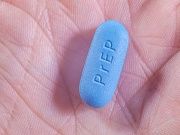Article
Electronic Medical Records Identify HIV PrEP Candidates
Author(s):
An automated algorithm was able to select HIV-positive individuals who would benefit the most from PrEP.

Researchers were able to identify individuals who had an increased risk of HIV and may benefit from pre-exposure prophylaxis (PrEP) by using an automated algorithm to analyze routine electronic health records (EHRs), according to MedPage Today.
In the study, researchers analyzed information from 800,000 patients at a large medical practice in Boston. Out of that number, the algorithm indicated that more than 8000 individuals were PrEP candidates.
The findings were presented at the annual IDWeek Meeting.
“The vast majority of patients in the general population have very low risk scores, but at the far end of the curve there’s an inflection point,” said researcher Douglas Krakower, MD. “It seems like there might be a sub population, based on the patterns observed in the data that may benefit from consideration of PrEP and other more intensive HIV prevention strategies.”
Although PrEP use has significantly increased in recent years, and more than 79,000 individuals have taken PrEP over the past 4 years in the United States, the CDC estimates that more than 1.2 million people can still potentially benefit from PrEP, MedPage reported.
One of the biggest challenges in getting people on board in taking PrEP is the lack of routine sexual health and risk evaluations, according to MedPage.
“We know that providers are very busy and have competing demands, and taking comprehensive sexual histories is challenging for several seasons including lack of training and lack of comfort having discussions about sexual health,” Krakower said, as reported by MedPage.
For the study, researchers obtained data from the EHRs of Atrius Health, which has about 800,000 patients at 27 sites, and evaluated more than 100 variables. Each newly infected HIV patient, between 2006 and 2015, were matched up with 100 control subjects of the same sex and similar length of Atrius membership who stayed HIV-negative, reported MedPage. Researchers then compared their risk factors and characteristics.
There were 138 HIV cases identified, of which 13,800 matched controls were chosen for the study. Logistic regression modeling and machine learning were used to predict HIV incident among cases versus the controls.
Computer algorithms were compared to each other and to logistic regression, which showed there were several machine learning methods successful in predicting incident HIV.
Lastly, researchers wanted to determine if the distribution of HIV prediction scores in the Atrius general population could suggest a subpopulation that may be candidates for PrEP, according to MedPage. Although a majority of the members were found to have a very low or low risk of HIV infection, there was a small proportion who were at high risk.
Using the algorithm, researchers found that 8414 patients of the general Atrius Health population were potential candidates for PrEP.
“Using STD diagnosis as a predictor of HIV risk is evidence-based, but it assumes that providers correctly screen patients — especially men who have sex with men – to actually capture the 70% of gonorrhea and chlamydia missed by urine-only testing,” said Demetre Daskalakis, MD in an interview with MedPage Today.
Newsletter
Stay informed on drug updates, treatment guidelines, and pharmacy practice trends—subscribe to Pharmacy Times for weekly clinical insights.






